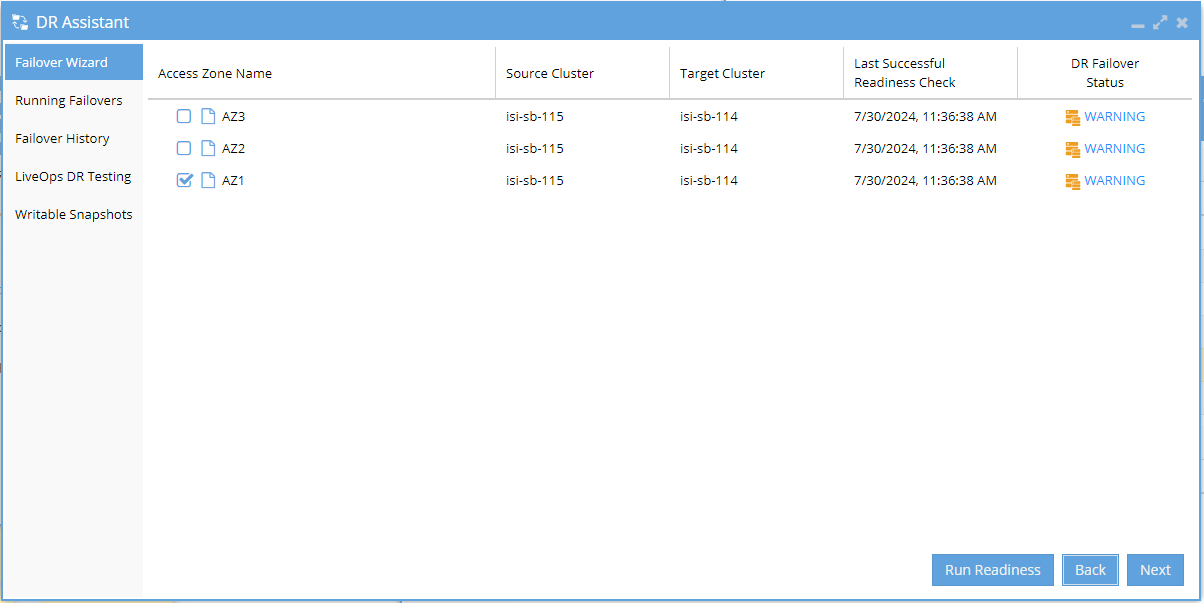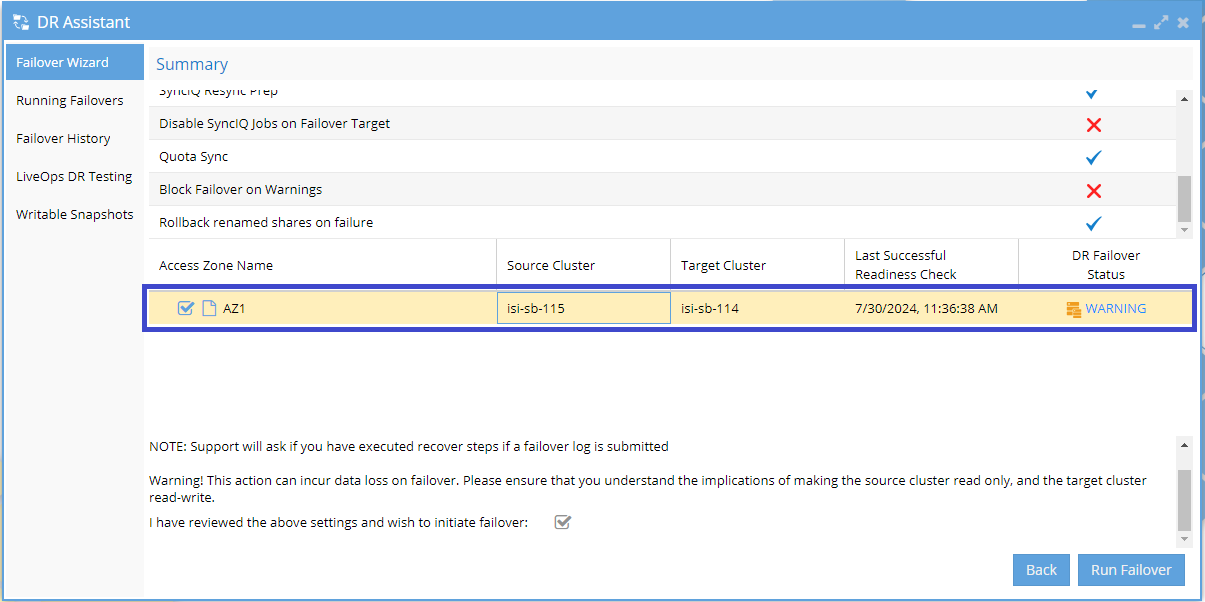Execute Failover with DR Assistant
Introduction
The DR Assistant is the guided interface that enables you to safely and systematically execute a storage cluster failover. Whether responding to a planned maintenance event or an unexpected outage, the DR Assistant provides structured steps to configure, initiate, and monitor the failover process from start to finish.
This section walks you through the workflow for launching a failover using pre-configured objects within your Superna environment. It also highlights critical failover options and safeguards that ensure data integrity and policy compliance during the transition.
Initiate a Failover
This section of the guide will cover the steps to start, monitor, and complete a failover.
Prerequisites:
- A storage cluster failover candidate
- A failover object candidate
Steps:
-
Access DR Assistant: From the Eyeglass Dashboard, select DR Assistant.
-
Select Storage Cluster: In the Failover Assistant section of DR Assistant, choose your storage cluster failover candidate from the Source Cluster dropdown menu.
-
Choose Failover Object: Select the type of failover object you want to failover from the Failover Type dropdown menu.
-
Enable/disable any applicable Failover Options. Not all options are available for all storage platforms. The available options are as follows:
-
Controlled Failover:
- Only uncheck this option if the source cluster is unreachable. Using this option means you are failing away from the data and losing all changes at the moment the failover is started. If this is unchecked, all failover will occur from an older snapshot and will result in data loss.
-
Data Sync:
- This option adds a step to the failover process to sync data between the source and target cluster before the failover begins. It’s recommended to keep this option enabled as it minimizes the amount of data that could be lost during a failover.
-
Config Sync:
- Synchronizes the configuration between the source and target clusters during failover.
-
SMB Data Integrity Failover:
- This option disconnects any active SMB sessions before the failover starts and ensures that no new sessions can be established on the failover source. This prevents data loss by ensuring no new data is written to the source cluster.
-
SyncIQ Resync Prep:
- Disabling this option is not recommended as it will leave the system in a state where you cannot use Eyeglass to fail back. This option is used only when customers plan to failover in one direction and then recreate a new policy, or they know how to manually recover and create a mirror policy.
-
Disable SyncIQ Jobs on Failover Target:
-
Disabling on failover is optional if you don’t want to configure failback and execute sync jobs in the return direction. This is used when you want to verify systems before replicating data back to the source.
warningUsing this option will require manual steps to fail back.
-
-
Quota Sync:
- This option will sync (i.e., copy the settings) quotas before failover on both the source and target.
-
Block Failover on Warnings:
- This option will stop a failover from proceeding if a WARNING status exists.
-
Rollback Renamed Shares on Failure:
- This option ensures that if the failover process fails, any shares that were renamed will be reverted to their original names.
-
-
Proceed with Your Selected Options:
- Once you have selected the failover option(s) you want, click the Next button in the bottom right corner to proceed.
-
Review Failover Support Policies:
- The next screen will display our failover support policies. Please read through them carefully, then select the checkbox and press Next to continue.
-
PowerScale OneFS Cluster Best Practices:
- If you selected a PowerScale OneFS cluster, you will see a Best Practices screen. Please review the information provided, then press Next to proceed.
-
Select Failover Objects:
- This screen will show the failover objects available to you based on the options you selected earlier (cluster and failover type).
- Use the checkboxes on the left side of the table to select the failover object(s) you wish to include, then click the Next button to proceed.
infoIf you believe your DR Failover Status has changed, you can select Run Readiness to update this status. The job usually takes up to 5 minutes to finish, but it may take longer depending on your configuration.

Review Success Screen:
- Assuming there are no errors, you should see a Success screen. Please review the failover release notes carefully, then click the checkbox to confirm you’ve read them, and press Next to continue.
-
Summary and Run Failover:
- This screen provides a summary overview of the selected failover object, including its DR Failover Status and the options that are enabled.
- After reviewing all the settings and ensuring they are correct, click the checkbox at the bottom of the window to confirm, and then click the Run Failover button to initiate the failover process.

-
Success!
- You have now successfully started a failover—congratulations! Next, we need to monitor the progress of the failover to ensure everything proceeds smoothly.
-
Monitor Individual Operations:
- While the failover is running, you can review the individual operations being executed in the Job Details section of the page.
- For a more detailed view, click the Logs hyperlink within the running failovers table to monitor the actions at a more granular level.
- We recommend opening the Failover Log Viewer and clicking the Watch button to stay up-to-date with the progress.
-
Handle Any Issues:
- If your failover encounters any issues, you can view them in the Job Details section by clicking the INFO hyperlink next to the particular job name.
-
Success!
- You have now successfully completed a failover—congratulations!
-
View Historical Failovers:
- You can view historical failovers by navigating to the Failover History menu item within the left navigation of DR Assistant.